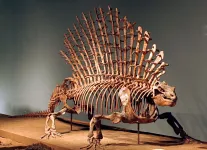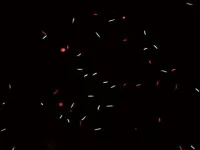(Press-News.org) In a new study from Shiley Eye Institute at UC San Diego Health, researchers have identified a potential new marker that shows cardiovascular disease may be present in a patient using an optical coherence tomography (OCT) scan -- a non-invasive diagnostic tool commonly used in ophthalmology and optometry clinics to create images of the retina. The finding suggests it may be possible to detect heart disease during an eye examination.
In the paper published March 2, 2021 in EClinical Medicine by The Lancet, the research team examined lesions of the retina, the inner-most, light-sensitive layer of the eye, to determine if a cardiovascular disorder may be present.
"The eyes are a window into our health, and many diseases can manifest in the eye; cardiovascular disease is no exception," said lead author Mathieu Bakhoum, MD, PhD, a physician-scientist and retina surgeon at UC San Diego Health. "Ischemia, which is decreased blood flow caused by heart disease, can lead to inadequate blood flow to the eye and may cause cells in the retina to die, leaving behind a permanent mark. We termed this mark 'retinal ischemic perivascular lesions,' or RIPLs, and sought to determine if this finding could serve as a biomarker for cardiovascular disease."
As part of the study, the team reviewed the records of individuals who received a retinal OCT scan at UC San Diego Health from July 2014 to July 2019. From that cohort, two groups were identified after medical chart review: one consisted of 84 individuals with heart disease and the other included 76 healthy individuals as the study's control group. An increased number of RIPLs was observed in the eyes of individuals with heart disease.
According to the researchers, the higher number of RIPLs in the eye, the higher the risk for cardiovascular disease.
"The only way we can visualize the smallest blood vessels in the body is in the eye. The retina in particular provides important evidence of the adverse effects of cardiovascular issues, such as high blood pressure," said Anthony DeMaria, MD, Judith and Jack White Chair in Cardiology and cardiologist at UC San Diego Health. "It's my hope that the presence of RIPLs in the eye will serve as a marker for cardiovascular disease when patients are undergoing assessment of risk factors for heart disease, or when patients are undergoing evaluation for the suspected presence of heart disease."
DeMaria said detection of RIPLs could result in identification of cardiovascular disease that would enable early therapy and preventative measures, and potentially reduce numbers of heart attacks or strokes.
A person's risk for cardiovascular disease is determined by the atherosclerotic cardiovascular disease (ASCVD) risk score calculator, the national guideline developed by the American College of Cardiology. The guideline is considered the gold standard for assessing a patient's 10-year risk of experiencing a cardiovascular event, such as heart attack or stroke. In the study, researchers found a correlation between the number of RIPLs in a patient's eye and their ASCVD risk score.
"Individuals with low and borderline ASCVD scores had a low number of RIPLs in their eyes, but as the ASCVD risk increased, so did the number of RIPLs," said Bakhoum.
Ophthalmologists at UC San Diego Health now consider referring patients to a cardiologist if RIPLs are identified during an OCT scan. The research teams hopes this paper and future studies will result in RIPLs becoming a common ophthalmological marker for identifying potential cardiovascular disease, and incorporated into the overall ASCVD risk score.
"Globally, cardiovascular disease is the number one cause of death and unfortunately many people are unaware they may have heart issues," said Bakhoum. "The key in preventing this is early detection and treatment. It's our hope that by identifying RIPLs as a marker for cardiovascular disease providers will be able to identify heart issues before a catastrophic event, such as a heart attack or a stroke, occurs."
INFORMATION:
Additional co-authors of the study include: Christopher P. Long, Alison X. Chan, Christine Y. Bakhoum, Samantha Madala, Anupam K. Garg, William R Freeman, Michael H. Goldbaum, all at UC San Diego; and Christopher B. Toomey, Wilmer Eye Institute.
No funding was reported for this research.
NEW YORK, NY--March 2, 2021--In March and April 2020, mental health claim lines for individuals aged 13-18, as a percentage of all medical claim lines, approximately doubled over the same months in the previous year. At the height of the spring wave of the COVID-19 pandemic, this rise in mental health claim lines amounted to 97.0 percent in March and 103.5 percent in April. These are among the many findings in FAIR Health's new white paper, the seventh in its COVID-19 studies, The Impact of COVID-19 on Pediatric Mental Health: A Study of Private Healthcare Claims.
In those same months of March and April 2020, all medical claim lines (including mental health claim lines) decreased by approximately ...
When it comes to the evolution of the mammal spine -- think of animals whose backbone allows them to gallop, hop, swim, run, or walk upright -- a key part of the tale is quite simple.
Because nonmammalian synapsids, the extinct forerunners to mammals, had similar traits to living reptiles (like having their limbs splayed out to the side instead of tucked into their body like today's mammals), the strongheld belief was that they must have also moved in similar ways. Primarily, their backbones must have moved side-to-side, bending like those of modern lizards, instead of the up-and-down bending motion mammal spines are known for. It's believed over time, and in response to selective pressures, the mammal spine evolved from that lizard like side-to-side bending ...
UNIVERSITY PARK, Pa. -- By modeling wolves in Yellowstone National Park, researchers have discovered that how a population is organized into social groups affects the spread of infectious diseases within the population. The findings may be applicable to any social species and could be useful in the protection of endangered species that suffer from disease invasion.
Like other social carnivores, wolves tend to form territorial social groups that are often aggressive toward each other and may lead to fatalities. During these encounters, infectious diseases -- like mange and canine distemper -- can spread between groups, which can further reduce the number of individuals in a group.
"Previous social group-disease models have assumed that groups do not change ...
WESTMINSTER, Colorado - March 02, 2021 - Herbicide-resistant weeds have fueled a growing demand for effective, nonchemical weed controls. Among the techniques used are chaff carts, impact mills and other harvest-time practices that remove or destroy weed seeds instead of leaving them on the field to sprout.
A recent article in the journal Weed Science explores whether such harvest-time controls would be effective against downy brome, Italian ryegrass, feral rye and rattail fescue - weeds that compete with winter wheat in the Pacific Northwest. Researchers set out to determine whether ...
New research has found that shrimp like creatures on the South Coast of England have 70 per cent less sperm than less polluted locations elsewhere in the world. The research also discovered that individuals living in the survey area are six times less numerous per square metre than those living in cleaner waters.
This discovery, published today in Aquatic Toxicology, mirrors similar findings in other creatures, including humans. The scientist leading research at the University of Portsmouth believes pollutants might be to blame, further highlighted by this ...
Resveratrol is a plant compound found primarily in red grapes and Japanese knotweed. Its synthetic variant has been approved as a food ingredient in the EU since 2016. At least in cell-based test systems, the substance has anti-inflammatory properties. A recent collaborative study by the Leibniz Institute for Food Systems Biology at the Technical University of Munich and the Institute of Physiological Chemistry at the University of Vienna has now shown that the bitter receptor TAS2R50 is involved in this effect. The team of scientists led by Veronika Somoza ...
CHICAGO, March 2, 2021 -- More than 70 percent of dentists surveyed by the American Dental Association (ADA) Health Policy Institute are seeing an increase of patients experiencing teeth grinding and clenching, conditions often associated with stress. This is an increase from ADA data released in the fall that showed just under 60 percent of dentists had seen an increase among their patients.
"Our polling has served as a barometer for pandemic stress affecting patients and communities seen through the eyes of dentists," said Marko Vujicic, Ph.D., chief economist and vice president of the ADA Health Policy Institute. "The increase over time suggests stress-related conditions have become substantially more prevalent since the onset of COVID-19."
The ...
BOSTON - Lymph nodes in the armpit area can become swollen after a COVID-19 vaccination, and this is a normal reaction that typically goes away with time. Radiologists at Massachusetts General Hospital (MGH) who recently published an approach to managing this situation in women who receive mammograms for breast cancer screening in the American Journal of Roentgenology have now expanded their recommendations to include care for patients who undergo other imaging tests for diverse medical reasons. Their guidance is published in the Journal of the American College of Radiology.
"Our ...
A new study published today in the journal Geophysical Research Letters used NASA's ice-measuring laser satellite to identify atmospheric river storms as a key driver of increased snowfall in West Antarctica during the 2019 austral winter.
These findings from scientists at Scripps Institution of Oceanography at the University of California San Diego and colleagues will help improve overall understanding of the processes driving change in Antarctica, and lead to better predictions of sea-level rise. The study was funded by NASA, with additional support from the Rhodium Group's Climate Impact Lab, a consortium ...
CLEVELAND - Researchers from Cleveland Clinic's Global Center for Pathogen Research & Human Health have developed a promising new COVID-19 vaccine candidate that utilizes nanotechnology and has shown strong efficacy in preclinical disease models.
According to new findings published in mBio, the vaccine produced potent neutralizing antibodies among preclinical models and also prevented infection and disease symptoms in the face of exposure to SARS-CoV-2 (the virus that causes COVID-19). An additional reason for the vaccine candidate's early appeal is that it may be thermostable, which would make it easier to transport and store than currently authorized COVID-19 ...






